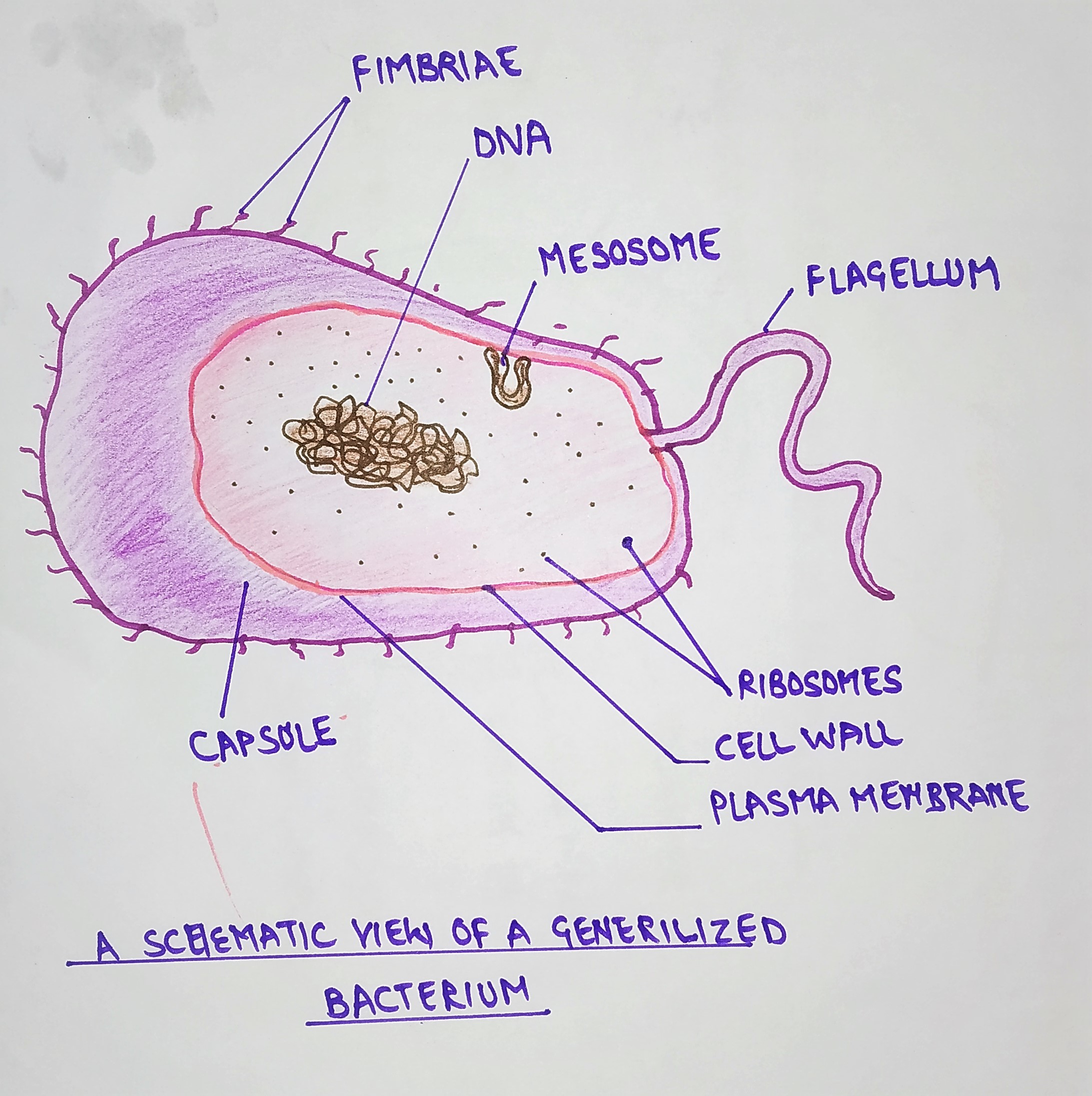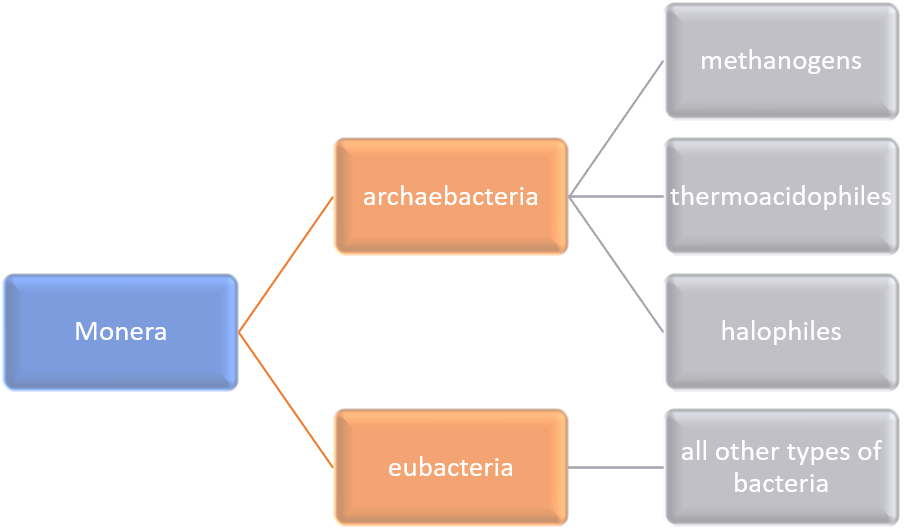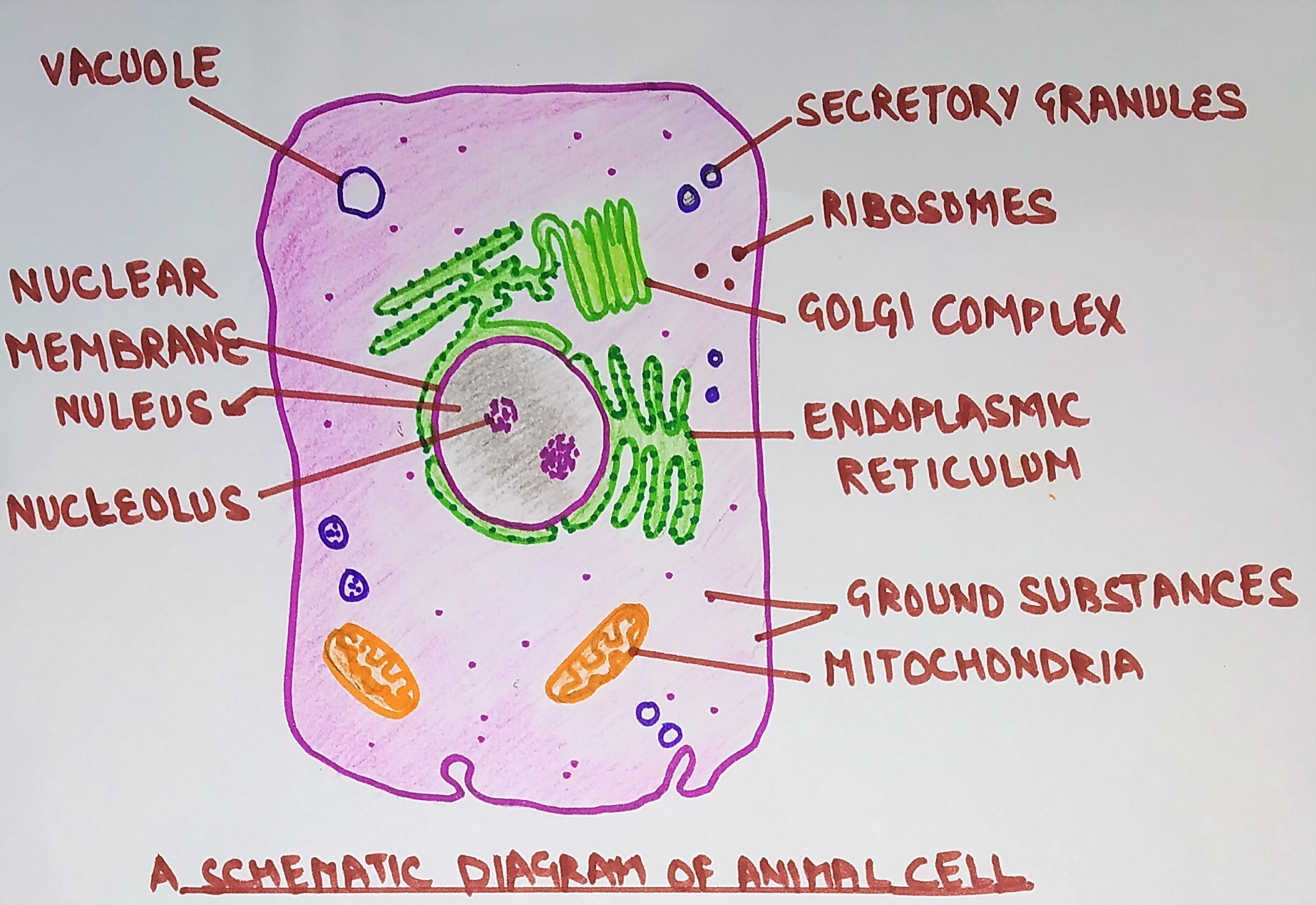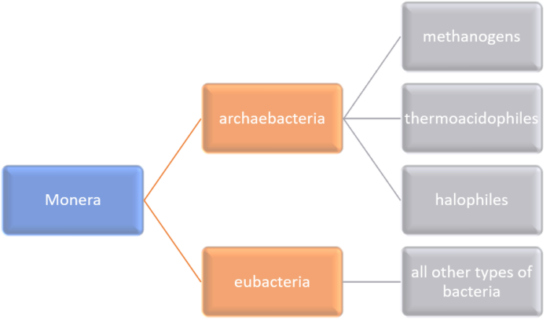Prokaryotes and eukaryotes….. hmm….
We all have heard these terms in our elementary school and almost each of us knows that prokaryotes are pre-existing cells and eukaryotes evolved later. In prokaryotes, the word ‘pro’ means before, and ‘kary’ means the nucleus (in the Greek language). Let me tell you some interesting things about prokaryotes. Do you know that prokaryotes were first discovered in the 1940s? The first eukaryote appeared almost 1.5 billion years ago. Prokaryotes, on the other hand, have existed for at least 3.5 billion years before and were the first form of life on Earth. Moreover, the prokaryotes and eukaryotes have various differences and similarities with respect to their structures.
Prokaryotes

As I mentioned earlier, ‘pro‘ means before and ‘
Classification of prokaryotes
Specifically, Prokaryotes come under the kingdom ‘Monera’. They are divided into two major subkingdoms:
- Archaebacteria
- eubacteria

Archaebacteria
methanogens
These are bacteria that involves in the production of methane gas from carbon dioxide and hydrogen gases. Example:- methanobacterium, methanosprillum, methanococcus.
Halophiles
‘Halo’ means salt, and ‘
Thermoacidophiles
The term ‘therm‘ means heat, and again ‘phile’ means loving. Thus, thermoacidophiles are bacteria that can live under highly acidic hot springs. For example, thermoplasma, Thermococcus.
Eubacteria
‘Eu’ means true. These bacteria are called true bacteria. The typical eubacteria cell ranges between 0.1-0.5 micrometers in diameter.
An example of eubacteria is mycoplasma. It is only 0.1 micrometers in diameter. It is the smallest living cell and the only prokaryote without the cell wall. These are tiny, irregularly shaped bacteria that can even pass through filter paper.
Mycoplasma is the simplest eubacteria. On the other hand, cyanobacteria are the most complex prokaryotic cell. Cyanobacteria is formerly known as blue-green algae because of their ability to form blue-green scum on the surface of freshwater bodies. Many of them are capable of photosynthesis and nitrogen fixation.
structure of prokaryotes
Nucleoid region
A prokaryotic cell lacks a true nucleus. Instead, it has a nucleoid region. The nucleoid serves its genetic material. It is an irregularly shaped region that contains the cell’s DNA. Moreover, it is not surrounded by a nuclear membrane.
Cytoplasm
The cytoplasm is gel-like substance. It is mainly comprises water.
Plasma membrane
The plasma membrane surrounds the
Flagella and Pili
The flagella and pili are hair-like structure present on the surface of the cell.
The cell wall
It is a non-living, semi-rigid component of the cell that surrounds the plasma membrane within the capsule. The cell wall is secreted and maintained by the living component of the cell wall, called protoplast. The thickness of the cell wall is the point of difference between archaebacteria and eubacteria. In addition to it, it also determines the gram reaction. The thicker cell wall gives gram-positive reaction and vice versa.
Functions of the cell wall
- it provides shape to the bacteria. In addition, it protects protoplasmic inclusions.
Eukaryotes

‘Eu’ means true and ‘
Eukaryotic cells can be
- unicellular
- multicellular
Unicellular eukaryotes
Unicellular eukaryotes are single-celled micro-organisms with a defined nucleus, mitochondria and other organelles. In unicellular eukaryotes, the single-cell performs all the activities including response to the environment, capturing of food, ejection of excess fluid, evading the predators, etc.
Unicellular eukaryotes examples
Unicellular eukaryotes are grouped into Kingdom Protista. Protista is a collection of single-celled organisms that do not fit into any other category. Most protists have both asexual and sexual reproductive phases
in their life cycles. Because protists are eukaryotic cells, in many respects their morphology and physiology are the same as the cells of multicellular plants and animals. They are a group made up of protozoa, unicellular algae, and slime molds.
Multicellular eukaryotes
In multicellular eukaryotic cells, different types of specialized cells carry out different functions. They have an advantage over unicellular eukaryotic cells as there is a division of labor among the cells of multicellular organisms. For example, disc-shaped RBCs (red blood cells) help in the transport of oxygen. Different types of cells acquire distinctive shapes and unique functions. For instance, cells present on digestive tract have the ability to secrete digestive enzymes.
Structure/components of eukaryotes
Unlike prokaryotes, eukaryotic cells have
- a membrane-bound nucleus
- numerous membrane-boun
d organelles, suchas, ER, the Golgi apparatus, chloroplast, mitochondria, cell wall, etc.
(organelles means ‘little organs’. Organelles have specialized cellular functions, likewise, organs of our body have specialized functions)
The cell wall
The cell wall is present in plant cells whereas, absent in animal cells. It comprises non-living material, secreted by the plasma membrane. Furthermore, a typical cell wall has three distinct regions, namely:
- primary wall ( thin and elastic)
- secondary wall ( thick and rigid)
- and, last but not the least, middle lamella.
The primary wall is present in growing cells since it is capable of expansion as the cell grows.
As a consequence of cell growth, the secondary wall formed. It is deposited on the primary wall towards the cytoplasm.
Middle lamella is present between the two adjacent cell walls. It formed during cell division.
The nucleus
It contains cell’s DNA, therefore directs the synthesis of ribosomes and proteins. The nucleus is present in all eukaryotic cells with some exceptions. For example:- matured erythrocytes (RBCs) in mammals, phloem cells, etc.
Mitochondria
Mitochondria is not only oval-shaped but also double-membrane organelles that have their own ribosome and DNA. Unquestionably, it is the powerhouse of the cell because they are responsible for making ATP. In particular, ATP is the cell’s main energy-carrying molecule.
Peroxisomes
They are small round organelles enclosed by a single membrane. Moreover, they carry out an oxidation reaction as a result of the breakdown of fatty acids and amino acids.
The plasma membrane
It separates the internal content of the cell from the surrounding environment. In addition to this, also controls the passage of organic molecules, ions, water, oxygen, in and out of the cell.
The cytoplasm
The cytoplasm is the entire region between the plasma membrane and the nuclear envelope. Along with protein synthesis, many metabolic reactions take place in it.
There are also other different cell organelles present in eukaryotes. If you wanted to know more in detail about these organelles you can read them here.
Now, let’s see what are the differences in eukaryotes and prokaryotes?
Difference between eukaryotic cell and prokaryotic cell
- Size: prokaryotic cell is generally smaller (1-10µm) whereas eukaryotic cell is larger (5-100µm)
- Genetic material: In prokaryotic cells, the genetic material is in the form of a large, circular molecule of deoxyribonucleic acid (DNA) while in eukaryotic cells, the nuclear DNA is linear and tightly bound to special proteins known as histones, forming a number of more complex chromosomes.
- Chromosome number: prokaryotes have single chromosomes. On the other hand, eukaryotes have multiple chromosomes.
- Membrane-bound organelles: they are absent in prokaryotes. On the contrary, various membrane-bound organelles are present in eukaryotes such as mitochondria, chloroplast, Golgi, ER, etc.
- Mesosomes: it is present in prokaryotes whereas absent in eukaryotes
- Ribosomes: the prokaryotic ribosome is
70S (50S+30S) and eukaryotic ribosome is 80S (60S+40S). - Cell wall: in prokaryotes, the cell wall is non-cellulosic, comprises of peptidoglycan. On the other hand, it is made up of peptidoglycan and is cellulosic.
- Cytoplasmic streaming: it is the movement of the fluid substance (cytoplasm) within a plant or animal cell. Unlike prokaryotes, it is present in eukaryotes.
- Energy metabolism: mitochondria are absent hence, oxidative enzymes are bound to the plasma membrane in case of prokaryotes. On the other hand, mitochondria are present in eukaryotes and oxidative enzymes are packaged within it.
- Cell division: prokaryotes reproduce by fission or budding whereas mitosis or meiosis occurs in eukaryotes.
Prokaryotic and eukaryotic cell Similarities
- Both cells are enclosed by a plasma membrane.
- Like prokaryotes, eukaryotes also have DNA as their genetic material. Both the cell contains RNA as well.
- some major metabolic pathways like glycolysis and TCA cycle are common in both the cell types.
- Both these organisms have a fluid-like matrix called the cytoplasm that fills the cells.
- All prokaryotic cells and unicellular eukaryotic cells have flagella; a thin thread-like structure attached to the outer surface of the cell. The flagella help in locomotion and chemotaxis.
- Cell organelles in prokaryotic cells as well as in eukaryotic cells held in place by the cytoplasm. In addition to this, the cytoplasm of both types of cells also has a similar composition.
- Both cell types are composed of proteins, carbohydrates, nucleic acids, fats, minerals, and vitamins.
- Both prokaryotic cells and eukaryotic cells contain complexes of protein and ribonucleic acid (RNA), known as ribosomes, that play a crucial role in the assembly of protein molecules from their amino acid subunits.
Short notes
Prokaryotes were first discovered in the 1940s. The
Prokaryotes
These primitive cells have a nucleoid but lack a nuclear membrane. Prokaryotes come under the kingdom ‘Monera’. They are divided into two major subkingdoms:
- Archaebacteria
- methanogens
- thermoacidophiles
- halophiles
- eubacteria
Archaebacteria
- methanogen: bacteria involved in the production of methane gas from carbon dioxide and hydrogen gases. Example:-
methanobacterium ,methanosprillum ,methanococcus . - Halophiles: can grow and survive under higher salt concentrations. For example, halobacterium.
- Thermoacidophile: can live under highly acidic hot springs. For example,
thermoplasma , Thermococcus.
Eubacteria
- called true bacteria
- ranges between 0.1-0.5 micrometers in diameter.
- Mycoplasma: the simplest and smallest eubacteria, only 0.1 micrometers in diameter. They can even pass filter paper.
- Cyanobacteria: most complex eukaryotic cells and formerly known as blue-green algae. They form blue-green scum on the surface of freshwater bodies and are capable of photosynthesis and nitrogen fixation.
structure of prokaryotes
- Nucleoid region: it is an irregularly shaped region that serves its genetic material. Not only it contains the cell’s DNA but also surrounded by nuclear region.
- Cytoplasm: it is a gel-like substance and mainly comprises of water.
- Plasma membrane: it surrounds the cytoplasm. In addition, it regulates the flow of substances in and out of the cell.
- Flagella and Pili: hair-like structure present on the surface of the cell.
- cell wall: non-living, semi-rigid component of the cell surrounded by the plasma membrane. It is secreted and maintained by protoplasm. The thicker cell wall gives gram-positive reaction whereas a thinner cell wall provides a
gram-negative reaction.- Function: provides shape to the bacteria and protects protoplasmic inclusions.
Eukaryotes
- eukaryotes are the cells that have a true membrane-bound nucleus.
- Eukaryotic cells can be unicellular or multicellular.
- Unicellular eukaryotes: the single-cell performs all the activities like capturing of food, ejection of excess fluid, evading the predators, etc. For example:- amoeba, paramecium, etc.
- Multicellular eukaryotes: In multicellular eukaryotic cells, different types of specialized cells carry out different functions. There is a division of labor among the cells of multicellular organisms. For example, disc-shaped RBCs (red blood cells) help in the transport of oxygen.
- eukaryotic cells have
- a membrane-bound nucleus
- numerous membrane-bound organelles, such as ER, the Golgi apparatus, chloroplast, mitochondria, cell wall, etc.
Structure of eukaryotes
- The cell wall: present in plant cells whereas, absent in animal cells. A typical cell wall has three distinct regions namely,
- primary wall: present in growing cells.
- secondary wall: deposited on the primary wall towards the cytoplasm.
- middle lamella: present in between the two adjacent cell walls.
- The nucleus: contains cell’s DNA, therefore directs the synthesis of ribosomes and proteins. It is present in all eukaryotic cells with some exceptions. For example:- matured erythrocytes (RBCs) in mammals, phloem cells, etc.
- Mitochondria: oval-shaped, double-membrane organelle. They are responsible for making
ATP molecule. - Peroxisomes: small round organelles enclosed by a single membrane.
- The plasma membrane: It separates the internal content of the cell from the surrounding environment. In addition to this, also controls the passage of organic molecules, ions, water, oxygen, in and out of the cell.
- The cytoplasm: it is the entire region between the plasma membrane and the nuclear envelope. Along with protein synthesis, many metabolic reactions take place in it.
Sources/references
Cell and molecular biology by Prakash S. Lohar, page no. 1-10, 16,
Cell biology: organelle structure and function by David E. Sadava.
Esau’s Plant Anatomy; Meristems, Cells, and Tissues of the Plant Body: Their Structure, Function, and Development, Third Edition by RAY F. EVERT, chapter no. 2: prokaryotic and eukaryotic cells.
